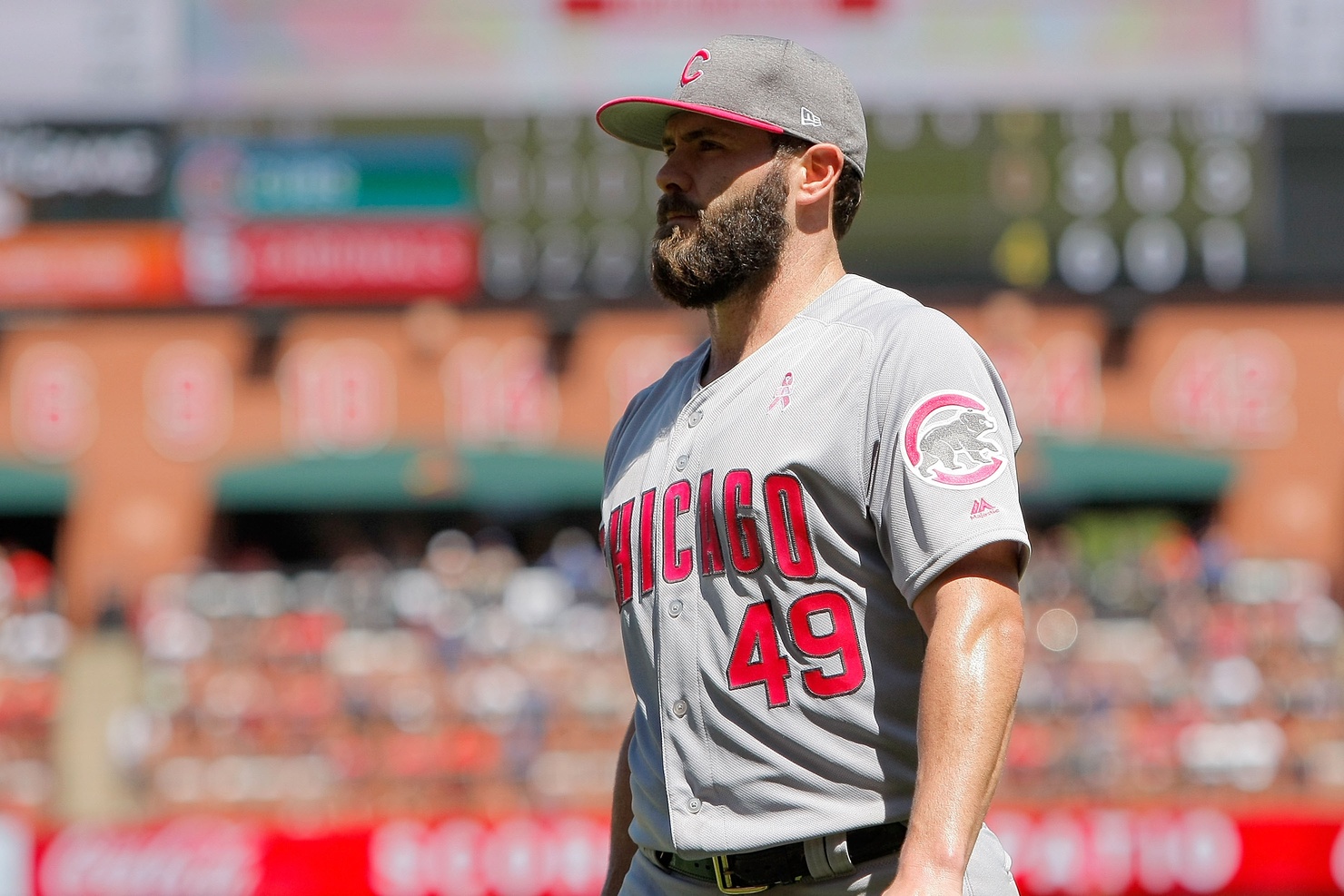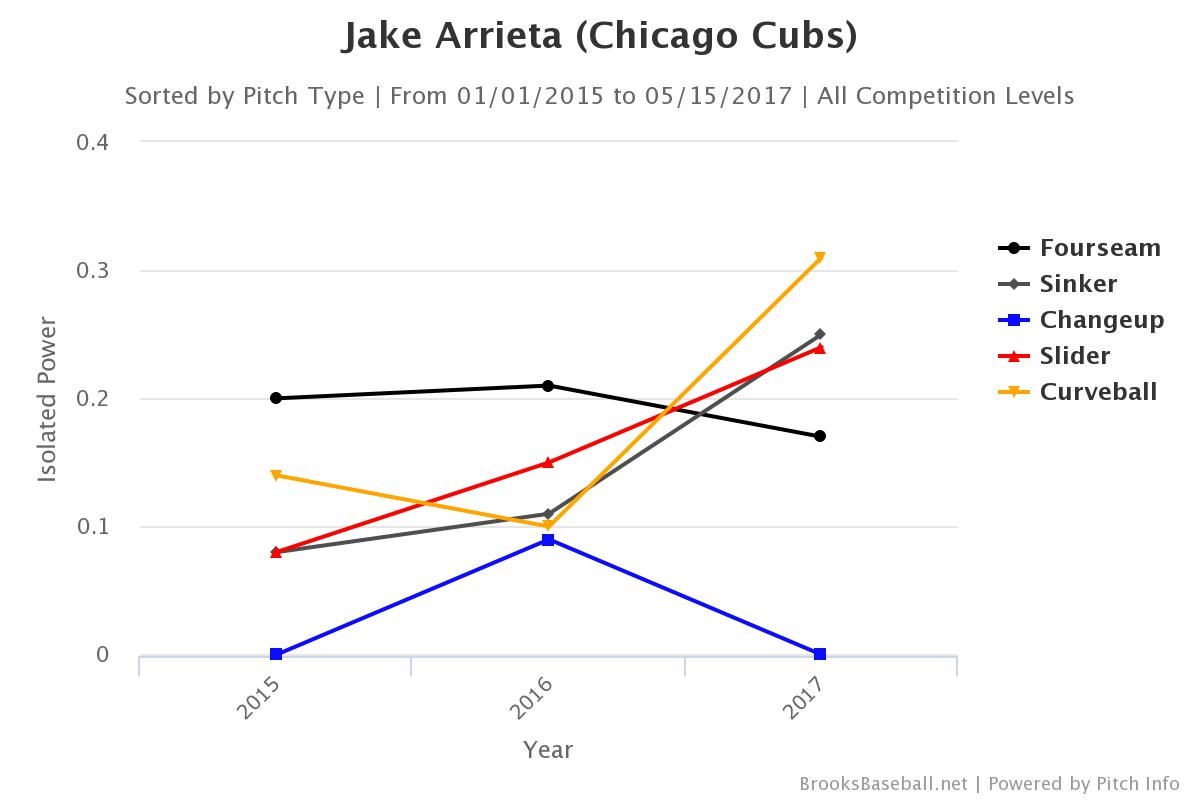The Chicago Cubs are not in a good place right now. They’re under .500, and there isn’t an area of the game in which anyone can declare that they’re actually excelling at this point. Despite some solid individual offensive and defensive performance, they haven’t put things together as a group in either respect. Same goes for the bullpen, where a few arms have been incredibly strong, but there’s a sense of foreboding when considering the group as a whole. But no element of this team has ignited concerns, or in some (many) cases drawn the ire, of the fanbase like the starting pitching.
And the justification is very much there for such an attitude toward this starting staff. A starting five that was so good and so steady throughout almost all of 2016 has labored through the first month-and-a-half of 2017, and there are very serious questions about where this team goes from here in regard to their starting pitching.
Eighty-percent of the rotation has carried over from last season, with Jon Lester, Jake Arrieta, John Lackey, and Kyle Hendricks all serving as holdovers. Brett Anderson was signed to serve as a stopgap in that fifth spot, with hope that the club would seek a longer term arm as the season wore on, perhaps even into the winter.
To say that things haven’t gone according to plan would be an understatement. At the same time, it is possible to look at this staff and be genuinely concerned, while also holding out hope and realizing that a lot could very well go in their favor as the season progresses. Of course, it’s certainly worth exploring which pitchers should be viewed through a lens of optimism and where the legitimate concern should lie at this point in the year. For the record, Brett Anderson is being omitted from this portion given his early level of misfortune, expected or not. We can reevaluate him at a later date, once he returns from the disabled list.
| IP | W-L | ERA | FIP | DRA | WHIP | K/9 | BB/9 | |
|---|---|---|---|---|---|---|---|---|
| Jon Lester | 47.0 | 1-2 | 3.45 | 3.73 | 2.41 | 1.40 | 9.4 | 3.8 |
| Jake Arrieta | 38.7 | 4-2 | 5.35 | 3.84 | 4.02 | 1.47 | 10.2 | 2.8 |
| John Lackey | 42 | 3-3 | 4.29 | 4.29 | 4.25 | 1.31 | 9.9 | 2.4 |
| Kyle Hendricks | 39.7 | 2-2 | 3.40 | 4.30 | 4.94 | 1.21 | 7.7 | 3.6 |
This doesn’t exactly paint the prettiest of pictures for anyone on the Cubs staff. Going by FIP and DRA does provide a bit of optimism for Lester, but none of these four is anywhere near where he was last season. Despite an improved strikeout rate, Lester has seen his walk rate, and subsequently his WHIP, rise from last year. Arrieta has improved his strikeout and walk rates, but has also been hit significantly harder than we’ve seen in recent years. Lackey continues to grind out starts and is well in line with where he was last year, though an increased BABIP is partially responsible for some of his early woes. And locator extraordinaire Kyle Hendricks hasn’t been able to demonstrate the type of command that made him such a raging success last year.
That’s the picture in an extremely general sense. There’s obviously a lot going on there, though, and with as many factors as there are to consider in relation to pitching, we could spend thousands of words to breaking down different aspects of each hurler. And in the long-term, we probably will. But for now, let’s simplify things a bit.
Let’s look a bit deeper here with some of the contact trends that has met each of these four starters this year:
| Avg FB Vel. | Swing% | Contact% | Whiff% | GB% | Soft% | Hard% | BABIP | |
|---|---|---|---|---|---|---|---|---|
| Jon Lester | 91.3 (No Change) | 41.4 (Down) | 73.5 (Down) | 10.8 (No Change) | 56% (Up) | 20.2% (Up) | 26.4 (No Change) | .331 |
| Jake Arrieta | 92.0 (Down) | 45.5 (No Change) | 76.7 (Up) | 10.0 (No Change) | 41% (Down) | 23.5 (Up) | 31.8 (Up) | .355 |
| John Lackey | 90.7 (Up) | 48.1 (No Change) | 76.4 (Up) | 10.1 (Down) | 48% (Up) | 16.1 (No Change) | 32.3 (Down) | .310 |
| Kyle Hendricks | 85.5 (Down) | 39.1 (Down) | 81.7 (Up) | 6.6 (Down) | 51% (Up) | 21.6 (Down) | 35.1 (Up) | .255 |
There’s a lot going on here, obviously. I should note that any category in which no change is indicated was one in which the deviation from their 2016 figure either didn’t fluctuate at all or remained within a percentage point of where it was last season. Regardless, there are some relatively simple conclusions that one can come to, in terms of where the concerns truly lie.
It’s hard to look at what Jon Lester has done throughout the season and get too concerned. His ERA is obviously up, and there’s more traffic than we saw last year because of an increased walk rate. However, his DRA and some of the contact trends above indicate that he’s been far better than it seems. His velocity has remained the same, his groundballs are up, and he’s inducing more soft contact than he did last year. He’s had to grind out at-bats more often, as hitters have shown more patience against him, which has driven up his pitch count early in games. That BABIP indicates he’s run into some bad luck as well.
And somewhat the same can be applied to John Lackey. At this point, we know what Lackey is. He’s improved his strikeout numbers, but he serves up quite a bit of contact. Offense is always going to need to be there to support him, but we’ve seen him when he’s in a groove and he’s quite effective in those situations. It’s frustrating to watch at times, especially when he tosses on days in which the offense falls silent, but we largely have to be accepting of what he is.
Then there’s the matter of Kyle Hendricks. His velocity is down and his command, which is what his entire game is predicated around, isn’t where it should be. The velocity is a concern because the MPH on his sinker has declined to the point where it’s far too close to his changeup. Brooks has the difference at 85.98 for the sinker and 79.19 for the change. At the same time, there has been steady improvement, with the velocity slowing rising over his last few starts, where he’s been far more effective. If the velocity can return to where it needs to be on a consistent basis, then a lot of Hendricks’ early issues should more than sort themselves out.
Which leaves Jake Arrieta as the primary point of concern. And much of what took place on Sunday against St. Louis was a microcosm of what has plagued him all year. Here are some of the above contact trends, presented in a context that features Arrieta’s performance over the last three seasons, including his first eight starts of 2017:
| Avg Vel | Swing% | Contact% | Whiff% | GB% | Soft% | Hard% | BABIP | |
|---|---|---|---|---|---|---|---|---|
| 2015 | 94.4 | 46.5 | 74.4 | 11.1 | 58% | 22.8 | 22.1 | .246 |
| 2016 | 93.6 | 45.1 | 74.8 | 10.5 | 54% | 22.9 | 25.2 | .241 |
| 2017 | 91.7 | 45.5 | 76.7 | 10.0 | 41% | 23.5 | 31.8 | .355 |
Given that his walk rate hasn’t risen, much of what is so very concerning about Arrieta relates directly back to the velocity dip. He’s topping out in the low-90s and serving up some seriously favorable contact for the opposition as a result. As a result, his tendency to allow extra base hits has risen almost across the board, regardless of pitch type:
That’s not something that shoring up the defense is going to help, either. Defensive support might aid Lester or Hendricks in getting them back where they need to be, but Arrieta’s velocity dip has led to the serving of many a meatball across his eight starts on the bump. What exactly the Cubs do to fix this isn’t entirely clear, either. Do they skip a start or even DL him to allow his arm to get back to where it needs to be? It’s not like you’re going to throw him in the bullpen at this point or take any other sort of rash action like that. This is a high-profile starting pitcher.
The good news is that the issues across the board aren’t quite as dire as they may initially seem. If Lester can start to put away hitters earlier in at-bats, he’ll be just fine. Hendricks has started to showcase a return to form, and as long as he can continue to regain his velocity, should be able to reestablish some of the effectiveness we saw last year. John Lackey just continues to grind in hopes that his offense will support him. The combination of Arrieta and a potentially empty fifth spot is a glaring concern, though.
Maybe Eddie Butler is a longer term guy than he may seem now, which would help to mitigate some of the concerns. Maybe, and this is less likely, Brett Anderson comes back from the DL and starts to get the ball on the ground at a rate closer to what we’ve seen throughout his career. But with the defense not at an elite level and the offense unable to gather itself as a unit, there’s not as much in place to compensate for the struggles of the starting pitching.
Luckily, there’s a lot of time for things to be sorted out, and the issues are relatively easy to pinpoint. It’s just a matter of approaching each with an appropriate solution. Whether that requires serious adjustments from the starters currently in place or seeking outside help remains to be seen. But if the Cubs are to return to anywhere near the level at which they performed the vast majority of 2016, it’s going to be on the shoulders of the starting pitching to get them there.
Lead photo courtesy Scott Kaine—USA Today Sports

